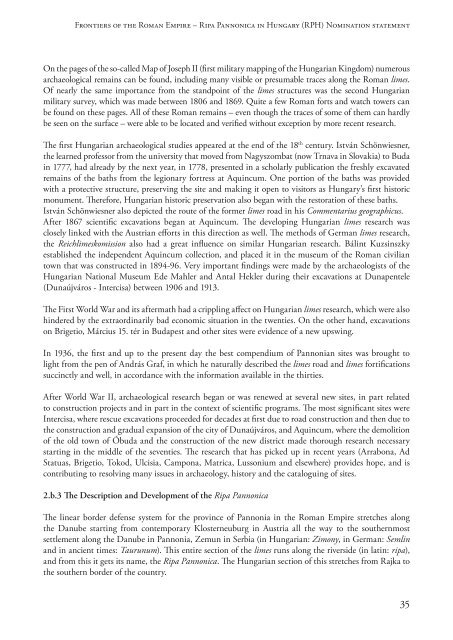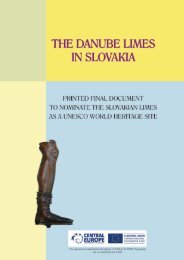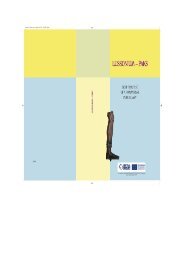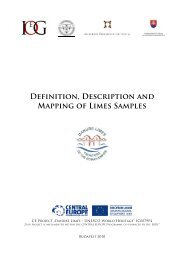the PDF version! - Danube Limes
the PDF version! - Danube Limes
the PDF version! - Danube Limes
Create successful ePaper yourself
Turn your PDF publications into a flip-book with our unique Google optimized e-Paper software.
Frontiers of <strong>the</strong> Roman Empire – Ripa Pannonica in Hungary (RPH) Nomination statement<br />
On <strong>the</strong> pages of <strong>the</strong> so-called Map of Joseph II (first military mapping of <strong>the</strong> Hungarian Kingdom) numerous<br />
archaeological remains can be found, including many visible or presumable traces along <strong>the</strong> Roman limes.<br />
Of nearly <strong>the</strong> same importance from <strong>the</strong> standpoint of <strong>the</strong> limes structures was <strong>the</strong> second Hungarian<br />
military survey, which was made between 1806 and 1869. Quite a few Roman forts and watch towers can<br />
be found on <strong>the</strong>se pages. All of <strong>the</strong>se Roman remains – even though <strong>the</strong> traces of some of <strong>the</strong>m can hardly<br />
be seen on <strong>the</strong> surface – were able to be located and verified without exception by more recent research.<br />
The first Hungarian archaeological studies appeared at <strong>the</strong> end of <strong>the</strong> 18 th century. István Schönwiesner,<br />
<strong>the</strong> learned professor from <strong>the</strong> university that moved from Nagyszombat (now Trnava in Slovakia) to Buda<br />
in 1777, had already by <strong>the</strong> next year, in 1778, presented in a scholarly publication <strong>the</strong> freshly excavated<br />
remains of <strong>the</strong> baths from <strong>the</strong> legionary fortress at Aquincum. One portion of <strong>the</strong> baths was provided<br />
with a protective structure, preserving <strong>the</strong> site and making it open to visitors as Hungary’s first historic<br />
monument. Therefore, Hungarian historic preservation also began with <strong>the</strong> restoration of <strong>the</strong>se baths.<br />
István Schönwiesner also depicted <strong>the</strong> route of <strong>the</strong> former limes road in his Commentarius geographicus.<br />
After 1867 scientific excavations began at Aquincum. The developing Hungarian limes research was<br />
closely linked with <strong>the</strong> Austrian efforts in this direction as well. The methods of German limes research,<br />
<strong>the</strong> Reichlimeskomission also had a great influence on similar Hungarian research. Bálint Kuzsinszky<br />
established <strong>the</strong> independent Aquincum collection, and placed it in <strong>the</strong> museum of <strong>the</strong> Roman civilian<br />
town that was constructed in 1894-96. Very important findings were made by <strong>the</strong> archaeologists of <strong>the</strong><br />
Hungarian National Museum Ede Mahler and Antal Hekler during <strong>the</strong>ir excavations at Dunapentele<br />
(Dunaújváros - Intercisa) between 1906 and 1913.<br />
The First World War and its aftermath had a crippling affect on Hungarian limes research, which were also<br />
hindered by <strong>the</strong> extraordinarily bad economic situation in <strong>the</strong> twenties. On <strong>the</strong> o<strong>the</strong>r hand, excavations<br />
on Brigetio, Március 15. tér in Budapest and o<strong>the</strong>r sites were evidence of a new upswing.<br />
In 1936, <strong>the</strong> first and up to <strong>the</strong> present day <strong>the</strong> best compendium of Pannonian sites was brought to<br />
light from <strong>the</strong> pen of András Graf, in which he naturally described <strong>the</strong> limes road and limes fortifications<br />
succinctly and well, in accordance with <strong>the</strong> information available in <strong>the</strong> thirties.<br />
After World War II, archaeological research began or was renewed at several new sites, in part related<br />
to construction projects and in part in <strong>the</strong> context of scientific programs. The most significant sites were<br />
Intercisa, where rescue excavations proceeded for decades at first due to road construction and <strong>the</strong>n due to<br />
<strong>the</strong> construction and gradual expansion of <strong>the</strong> city of Dunaújváros, and Aquincum, where <strong>the</strong> demolition<br />
of <strong>the</strong> old town of Óbuda and <strong>the</strong> construction of <strong>the</strong> new district made thorough research necessary<br />
starting in <strong>the</strong> middle of <strong>the</strong> seventies. The research that has picked up in recent years (Arrabona, Ad<br />
Statuas, Brigetio, Tokod, Ulcisia, Campona, Matrica, Lussonium and elsewhere) provides hope, and is<br />
contributing to resolving many issues in archaeology, history and <strong>the</strong> cataloguing of sites.<br />
2.b.3 The Description and Development of <strong>the</strong> Ripa Pannonica<br />
The linear border defense system for <strong>the</strong> province of Pannonia in <strong>the</strong> Roman Empire stretches along<br />
<strong>the</strong> <strong>Danube</strong> starting from contemporary Klosterneuburg in Austria all <strong>the</strong> way to <strong>the</strong> sou<strong>the</strong>rnmost<br />
settlement along <strong>the</strong> <strong>Danube</strong> in Pannonia, Zemun in Serbia (in Hungarian: Zimony, in German: Semlin<br />
and in ancient times: Taurunum). This entire section of <strong>the</strong> limes runs along <strong>the</strong> riverside (in latin: ripa),<br />
and from this it gets its name, <strong>the</strong> Ripa Pannonica. The Hungarian section of this stretches from Rajka to<br />
<strong>the</strong> sou<strong>the</strong>rn border of <strong>the</strong> country.<br />
35











